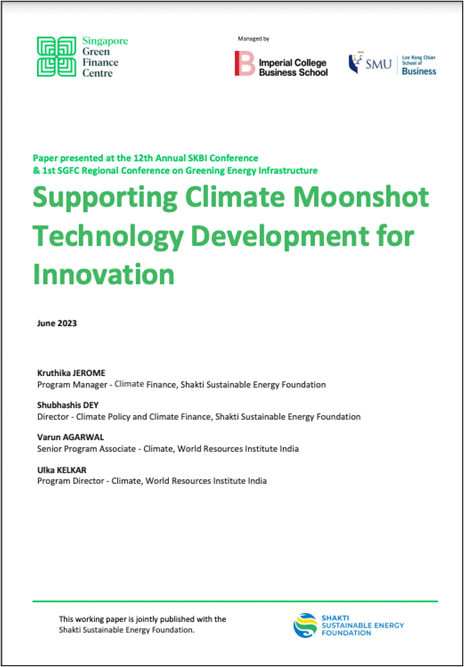Paper : Supporting Climate Moonshot Technology Development for Innovation published by Singapore Management University
July 3, 2023 by shakti-admin
The Paper presented at the 12th Annual SKBI Conference & 1st SGFC Regional Conference on Greening Energy Infrastructure, ‘Supporting Climate Moonshot Technology Development for Innovation’ was co-authored by Kruthika Jerome, Programme Manager, Climate Finance, Shakti and Shubhashis Dey, Director, Climate Policy and Climate Finance, Shakti along with other authors was published by Singapore Management University
India has set ambitious goals following COP26, including a 2070 net-zero target and installation of 500 GW of non-fossil fuel electricity capacity by 2030. In conjunction with its climate targets, it remains committed to national priorities on poverty alleviation, strong economic growth, gainful employment and attainment of various other SDGs. This necessitates a new growth paradigm that examines the energy transition challenge as an opportunity for transforming India from a labour-intensive, middle income, developing market economy to a smart economy. The study examines climate frontier moonshot technology solutions in light of India’s transitional challenges and developmental ambitions.
For smooth transitioning, technology solutions would need to be developed and integrated across power, industry and transport sector on priority. India’s transitional challenges can therefore be grouped under three broad categories – scaling green energy generation capacity; effective storage; and industrial decarbonisation. Despite rapid development of solar and wind capacity, scaling up non-fossil fuel electricity capacity to 500GW in 2030 and upto 2500 GW by 2050 through large-scale solar and wind power plants could be impacted critically due to vast requirement of land in business as usual scenario. Going forward, competing land requirements for food security, nature conservation and housing needs of a growing population, would further contribute to scarcity of available land. To mitigate this, alternate technology solutions such as offshore wind could be explored. Fungibilities with development of green hydrogen production capacity offers increased decarbonisation potential within hard-to-abate sectors such as steel, chemical and cement but would require policies for market creation, demand aggregation, and scale economies. Installed renewable capacity would additionally need to be complemented with development of battery storage technology capacity to achieve India’s 2030 and 2070 targets, in the face of limitations posed by geographic availability of climate and mineral reserves along with incipient infrastructural setup. Together, these solutions hold the key to unlocking energy transition in India. However, technology deployment in these segments exists at a very nascent stage in the country.
The paper therefore examines the abovementioned priority technologies within the three categories by studying the estimated financing requirements, ecosystem barriers and existing technology maturity. It specifically focuses on the role of state in facilitating the respective technology development and deployment within the country. By referring to past instances of frontier technology development in the country, using space research and biopharmaceutical research as case studies, the study drew inferences on successful innovation governance models and associated institutional capabilities. It finds that a dedicated governance mechanism in form of an integrated commission on energy transition will accelerate innovation in the country, when combined with creation of a robust research and development infrastructure along with market creation and stabilisation support. The latter can be operationalised through industry-academia-government tri-partnerships, increased R&D expenditure and financial de-risking as opposed to pure subsidy support. In the present landscape, India has a unique opportunity to position itself as a burgeoning leader in climate research and high-value technology exports by making strategic investments in the proposed interventions. Read more
